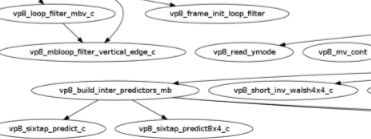UPDATE, 2010-06-17: You don’t need to struggle through these instructions anymore. libvpx 0.9.1 and FFmpeg 0.6 work together much better. Please see this post for simple instructions on getting up and running quickly.
Let’s take the VP8 source code (in Google’s new libvpx library) for a spin; get it to compile and hook it up to FFmpeg. I am hesitant to publish specific instructions for building in the somewhat hackish manner available on day 1 (download FFmpeg at a certain revision and apply a patch) since that kind of post has a tendency to rise in Google rankings. I will just need to remember to update this post after the library patches are applied to the official FFmpeg tree.
Statement of libvpx’s Relationship to FFmpeg
I don’t necessarily speak officially for FFmpeg. But I’ve been with the project long enough to explain how certain things work.
Certainly, some may wonder if FFmpeg will incorporate Google’s newly open sourced libvpx library into FFmpeg. In the near term, FFmpeg will support encoding and decoding VP8 via external library as it does with a number of other libraries (most popularly, libx264). FFmpeg will not adopt the code for its own codebase, even if the license may allow it. That just isn’t how the FFmpeg crew rolls.
In the longer term, expect the FFmpeg project to develop an independent, interoperable implementation of the VP8 decoder. Sometime after that, there may also be an independent VP8 encoder as well.
Building libvpx
Download and build libvpx. This is a basic ‘configure && make’ process. The build process creates a static library, a bunch of header files, and 14 utilities. A bunch of these utilities operate on a file format called IVF which is apparently a simple transport method for VP8. I have recorded the file format on the wiki.
We could use a decoder for this in the FFmpeg code base for testing VP8 in the future. Who’s game? Just as I was proofreading this post, I saw that David Conrad has sent an IVF demuxer to the ffmpeg-devel list.
There doesn’t seem to be a ‘make install’ step for the library. Instead, go into the overly long directory (on my system, this is generated as vpx-vp8-nopost-nodocs-generic-gnu-v0.9.0), copy the contents of include/ to /usr/local/include and the static library in lib/ to /usr/local/lib .
Building FFmpeg with libvpx
Download FFmpeg source code at the revision specified or take your chances with the latest version (as I did). Download and apply provided patches. This part hurts since there is one diff per file. Most of them applied for me.
Configure FFmpeg with 'configure --enable-libvpx_vp8 --enable-pthreads'. Ideally, this should yield no complaints and ‘libvpx_vp8’ should show up in the enabled decoders and encoders sections. The library apparently relies on threading which is why '--enable-pthreads' is necessary. After I did this, I was able to create a new webm/VP8/Vorbis file simply with:
ffmpeg -i input_file output_file.webm
Unfortunately, I can’t complete the round trip as decoding doesn’t seem to work. Passing the generated .webm file back into FFmpeg results in a bunch of errors of this format:
[libvpx_vp8 @ 0x8c4ab20]v0.9.0 [libvpx_vp8 @ 0x8c4ab20]Failed to initialize decoder: Codec does not implement requested capability
Maybe this is the FFmpeg revision mismatch biting me.
FFmpeg Presets
FFmpeg features support for preset files which contain collections of tuning options to be loaded into the program. Google provided some presets along with their FFmpeg patches:
- 1080p50
- 1080p
- 360p
- 720p50
- 720p
To invoke one of these (assuming the program has been installed via ‘make install’ so that the presets are in the right place):
ffmpeg -i input_file -vcodec libvpx_vp8 -vpre 720p output_file.webm
This will use a set of parameters that are known to do well when encoding a 720p video.
Code Paths
One of goals with this post was to visualize a call graph after I got the decoder hooked up to FFmpeg. Fortunately, this recon is greatly simplified by libvpx’s simple_decoder utility. Steps:
- Build libvpx with
--enable-gprof - Run simple_decoder on an IVF file
- Get the pl_from_gprof.pl and dot_from_pl.pl scripts frome Graphviz’s gprof filters
- gprof simple_decoder | ./pl_from_gprof.pl | ./dot_from_pl.pl > 001.dot
- Remove the 2 [graph] and 1 [node] modifiers from the dot file (they only make the resulting graph very hard to read)
- dot -Tpng 001.dot > 001.png
Here are call graphs generated from decoding test vectors 001 and 017.
It’s funny to see several functions calling an empty bubble. Probably nothing to worry about. More interesting is the fact that a lot of function_c() functions are called. The ‘_c’ at the end is important– that generally indicates that there are (or could be) SIMD-optimized versions. I know this codebase has plenty of assembly. All of the x86 ASM files appear to be written such that they could be compiled with NASM.
Leftovers
One interesting item in the code was vpx_scale/leapster. Is this in reference to the Leapster handheld educational gaming unit? Based on this item from 2005 (archive.org copy), some Leapster titles probably used VP6. This reminds me of finding references to the PlayStation in Duck/On2’s original VpVision source release. I don’t know of any PlayStation games that used Duck’s original codecs but with thousands to choose from, it’s possible that we may find a few some day.
